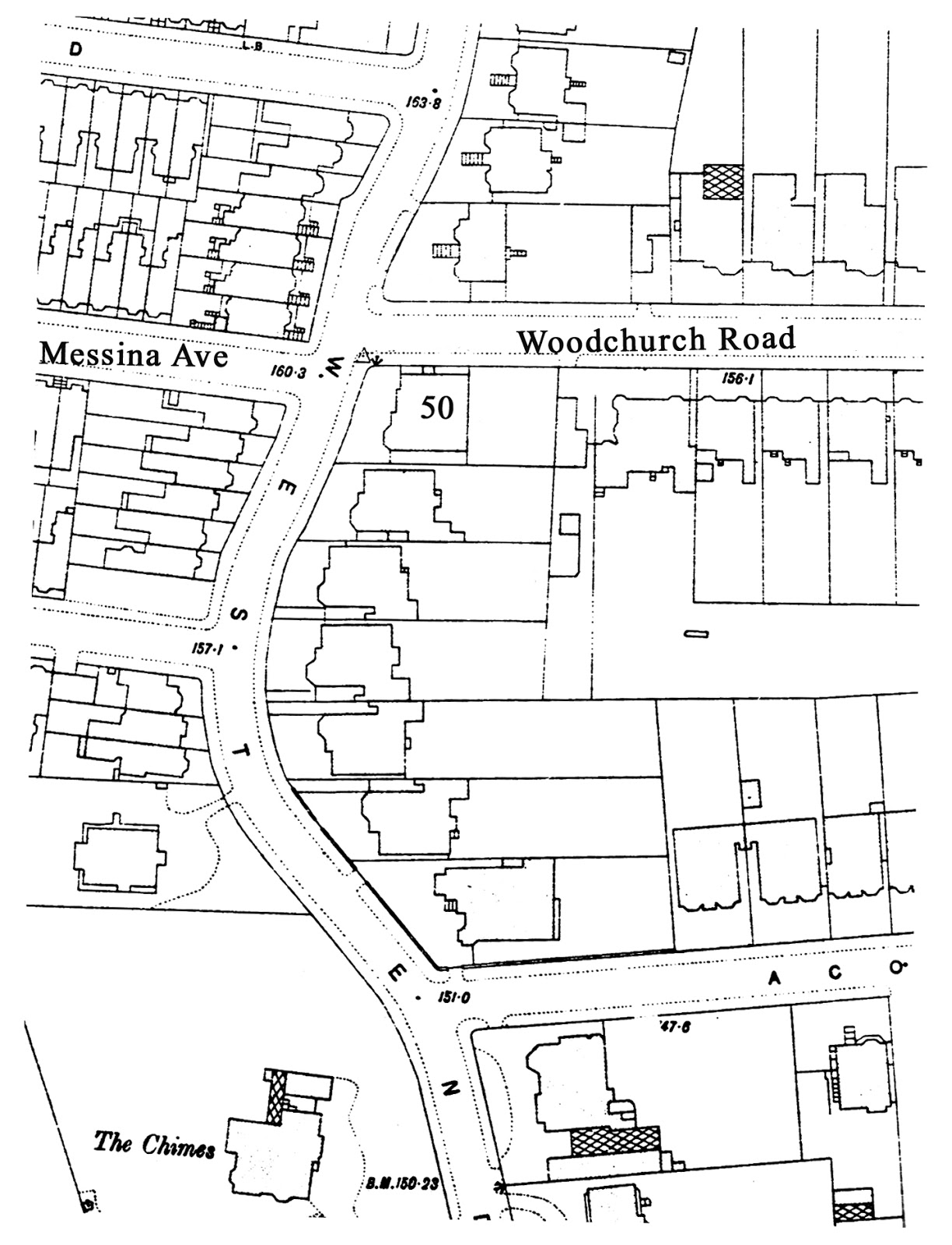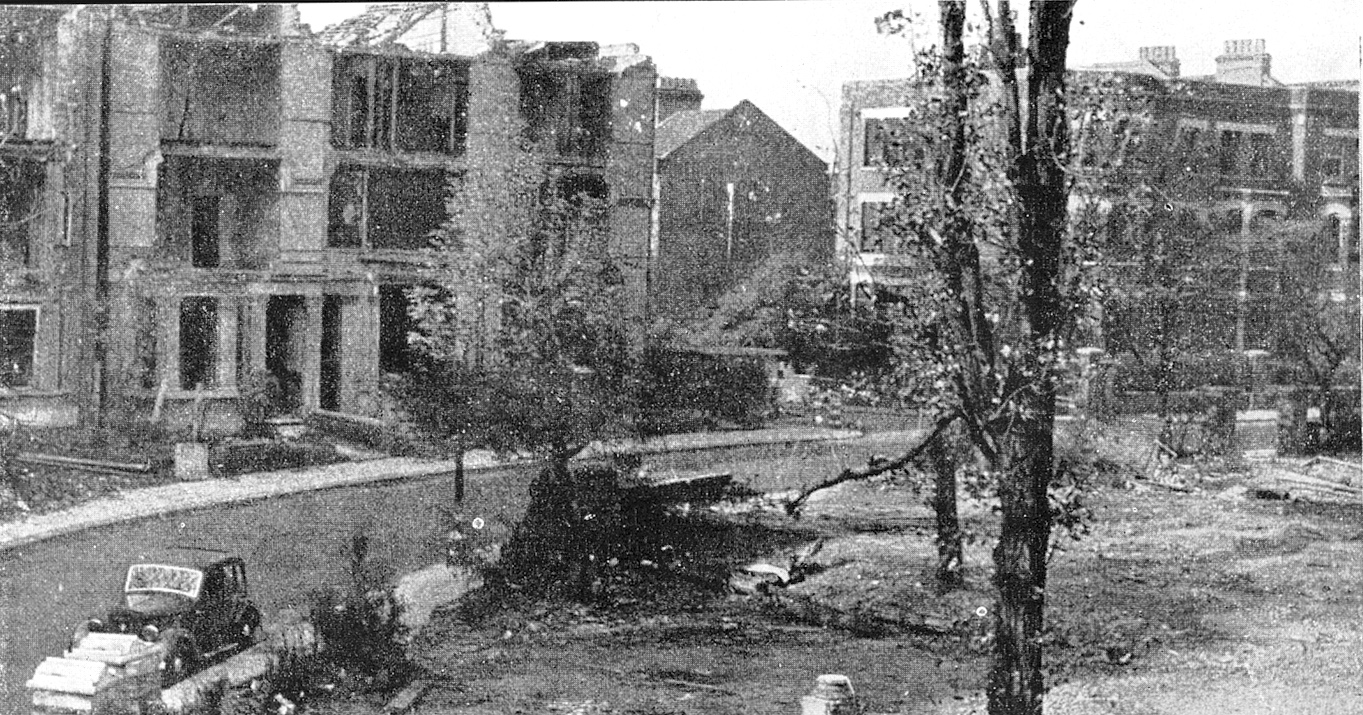Gerry Anderson in West Hampstead
You may have heard that Gerry Anderson, the creator of Thunderbirds, died on the 26 December 2012. What is less well-known is that he grew up in West Hampstead, in a ‘squalid house’ off West End Lane, according to his biography. When Dick spoke to him a few years ago, Gerry said he couldn’t remember exactly where he’d lived but it was at the top of a large house on West End Lane, with a tent-shaped glass roof over the front door. There was a garage with a driveway at the side. The family of four lived in poverty in one room, with a blanket hung up to separate the cooking area from the sleeping area. They shared a bathroom with the other tenants who included: a rather sinister ex-convict, an eccentric artist, and a woman who later Gerry realised was probably a prostitute.
Gerry went to Kingsgate Infants School. His mother would see him across West End Lane, then he walked by himself down Cotleigh Road to the school. He said he hated the afternoon rest period when the children were forced to sleep, resting their heads on the sloping desks. He was only five, but thought it was a ridiculous waste of time. After school he would climb back up the hill and wait at the main road. His mother would be watching at the window across West End Lane, then she would wave and come down to collect him. Gerry remembered the excitement of going to the cinema each week at the Kilburn State or The Grange. He and his mother would sit in the six penny front row stalls. Movietone News and The March of Time were followed by a couple of cartoons and two feature films – lavish Hollywood films and British B movies.
Using the Electoral Registers, Marianne and Dick have worked out for the first time exactly where Gerry lived in West Hampstead. His parents Joseph and Deborah Abrahams are shown at 50 West End Lane from 1929 to 1935. This was a large detached house on the corner of Woodchurch Road.
 |
| 50 West End Lane, 1890s OS Map |
Gerry Anderson was born Gerald Alexander Abrahams, on 14 April 1929, in the Elizabeth Garrett Anderson Hospital. His parents, Joseph Abrahams and Deborah Leonoff, were married in the Rochford area of Essex, which includes Westcliff-on-sea and Southend, in 1921.
His grandparents, the Bielogovski family who came from Russia, took the name of Abrahams on their arrival in London’s East India dock in 1895. The family settled in Westcliff-on-sea. Their son Joseph worked as the manager of a clothing company for his brother Michael. At the company he met an attractive clerical assistant called Deborah Leonoff, who lived in Hackney, and she agreed to marry him. They moved to Willesden Green, but theirs was a stormy relationship with lots of rows. Joseph, an ardent socialist, argued with his brother about business and wealth. He left the clothing company and worked installing tobacco dispensing machines in private homes. A packet of 20 cigarettes cost one shilling and Joseph visited the customers on his bicycle, to fill the machines and collect the cash. But money was tight and the family had to move into the single room at the top of 50 West End Lane. Joseph was a classical pianist and they found space for an upright piano. The woman in the room below would complain about the noise, banging on the ceiling with her broomstick. When the ex-convict opposite moved, Deborah pleaded with Joseph to rent the vacant flat. He reluctantly agreed and they moved into three rooms and a small kitchen. But Gerry believed his father couldn’t really afford the higher rent. When Gerry was five he suffered from German measles and like many children at the time he was hospitalized for six weeks, followed by four weeks in a convalescent home. He was surprised when he came home to find some brightly painted lead cars and a set of traffic lights arranged in a street scene on a green baize card table. Deborah had bought them, with help from the prostitute neighbour.
In 1936 the family moved to 50A Clifford Way, Neasden. Three years later they moved again, to 198 Neasden Lane where they stayed for many years. In the years before WW2, Gerry and his mother experienced anti-Semitism. Gerry remembers being circled by boys in the Braincroft school playground who ridiculed him chanting ‘Jew Boy,’ until a teacher came to his rescue. When a laundry boy came to the house to collect the weekly washing and saw the name Abrahams on the bundle, he threw it back at Gerry’s mother shouting, ‘We don’t collect laundry from Jews.’ Gerry and hismother pleaded with Joseph to change their name and in November 1939 it was changed from Abrahams to Anderson. This was just a name that Deborah liked, but later it led some people to believe that Gerry had Scottish roots! When he became successful, Gerry spent over £3,000 on a new bungalow for his parents in Maidenhead, allowing them to leave their rented flat in Neasden Lane. Joseph Anderson died in Maidenhead Hospital in 1965. His mother Deborah died in Wrexham Park Hospital, Slough in the 1970s.
Gerry’s older brother Lionel was born in 1922 in the Westcliff-on-sea area. When War was declared, he joined the RAF aged just seventeen, and went to Arizona for training. Gerry remembered one of his brother’s letters talked about flying over an air base called ‘Thunderbird Field.’ This stuck in his memory and he used it for the title of his puppet series. Gerry was impressed when Lionel came home as a uniformed Flight Sergeant flying Mosquitoes with 515 Squadron. One day when he flew very low over the house, Gerry jumped up and down with pride and excitement. Lionel successfully flew 38 missions but he died on 27 April 1944, when his plane was shot down during an attack over Holland. He was 22 years old.
Gerry worked in the film industry and became famous for his TV puppet films, but he said he always wanted to make films with real actors.
50 West End Lane
Before Gerry Anderson lived there, the large corner house was built in 1881 for wealthy professionals. It was occupied until 1883 by William John Vereker Bindon, a doctor who called it ‘Appin’. He was born in the Cape of Good Hope, South Africa, and did his medical training in Edinburgh. He married Jemima Downie in 1874. They came to London where he practised in Kilburn, living first at Elm Villas, Willesden Lane. Then in 1881 they moved to the newly built 50 West End Lane. In October 1882 William had an affair with one of his patients, Hannah Smith, the wife of the composer Edward Sydney Smith who lived at 28 Birchington Road. In 1883 Jemima sued William for divorce on the grounds of cruelty and adultery and was granted a divorce. At the trial Blanche Augustine Pinget, a French maid working for Mrs Smith said she’d seen Dr Bindon kissing Mrs Smith in her bedroom. There were two unhappy marriages, as Sydney Smith was having an affair with Blanche whom he married after Hannah died in 1886. Dr Bindon went to Australia where he died in 1891.
50 West End Lane was put up for sale in 1883. The sale details give us a good description of the house:
For sale by auction. ‘Appin’, West End Lane, a superior family residence conveniently situated a few minutes walk from West Hampstead Station, on the Harrow branch of the Metropolitan Railway and the West End Station on the Midland Railway. The house, which is of pleasing elevation, is approached through a front garden, and has a spacious garden with a tennis court in the rear; it contains, on the two upper floors, nine principal and secondary bedchambers, a large studio, a bath room with hot and cold bath, a box room, housemaid’s closet etc; on the ground floor, entrance and inner halls, excellent lofty drawing room, dinning room, and library, a surgery, with separate side entrance from Woodchurch Road, lavatory, etc, also kitchen scullery, and pantry with serving hatch, and spacious cellarage in the basement.
It was bought by Albert Joseph Altman who changed the name of the house to ‘Elmira’. Altman was a wealthy sports and games manufacturer at Aldersgate Street who made croquet and cricket equipment. In 1876 as a City Alderman he became the Chairman of a Special Committee set up to consider the fifty designs for a new bridge over the Thames. When Tower Bridge was finally opened in 1894 he was knighted for his services. Altman was at the West End Lanehouse until 1890.
Other owners of the house were doctors and merchants. In December 1927, 50 West End Lane was sold at auction by Leopold Farmer and Sons for £3,150. At this point it became a lodging house let out in nine small flats or single rooms. It remained like this until mid-June 1944 when the first of ten V1 doodlebugs to hit Hampstead, exploded behind 42 West End Lane and destroyed the neighbouring houses. Seventeen people died and others were badly wounded. One woman was rescued alive after being buried for 48 hours.
 |
| 1944 Bomb damage, looking across West End Lane towards Gascony Avenue (Camden Local History Archives) |
Michael Alpert, who lived just off West End Lane, remembers the day the VI fell and has written the following account:
When very early on a Monday morning in June 1944 that the VI crashed on West End Lane, I was awakened by the sound of breaking glass caused by the blast. My father was in the army and I was asleep with my mother in Smyrna Mansions, just off Gascony Avenue, which can be seen in the centre of the photograph above. I was eight years old.
My mother gathered me up and we went down to the street shelter opposite the Mansions. After a time we went back to the flat. My mother’s calm was amazing. She made up a bed for me in the large front room which looks over Smyrna Road and had been less affected by the bomb blast than the rooms at the back of the flat, while she sat doing the accounts for the milk bar which she ran in Kilburn High Road.
It was mid-summer and the early morning was very mild and light. As soon as possible my mother got me ready to go to the weekly boarding school which I attended and to which I used to return on Monday mornings. Since we had no gas and probably no water from the bomb blast, my mother could not give me breakfast, so when we arrived she asked the matron to give me something to eat and drink. At morning assembly that day I said, with some exaggeration, that we had been ‘bombed out’, which was the expression used then.
I went to school by train in East Sheen, via Richmond, on what is now the Overground. I remember only one delay in all the years I travelled on that line, and once being held outside Willesden Junction during an air raid, when all trains had to stop lest they fall into a bomb crater.
From summer 1944 onwards as soon as you heard the ominous buzz of the flying bomb, followed by the motor cutting-out, you knew that the doodlebug would crash in about twenty seconds, so you made a dash for the street shelter, which was said to be proof against everything but a direct hit. At school we slept in a shelter covered with corrugated iron and earth in the garden. The smell of damp earth always brings the memory back. In the street shelter, of which there were two in Smyrna Road, each household had a little sort of cell with bunks. I think we continued to sleep in shelters until early January 1945. For a few weeks a more powerful and faster rocket, the V2, fell and caused immense destruction and loss of life. There was no warning of its arrival. Luckily the launching pads were overrun before life in Britain was nearly paralysed.
For many years afterwards we played in the bombed buildings, including those on West End Lane. It was, I suppose, dangerous to do so, because floors and stairs could easily give way, but it was great fun for a young boy.
The frontage of West End Lane between Acol and Woodchurch Roads remained a bomb site until the Council completed the 80 flats in Sidney Boyd Court in 1953.
 |
|||||||
| Sidney Boyd Court Today |
 |
| Corner of Sidney Boyd Court, site of 50 West End Lane |


